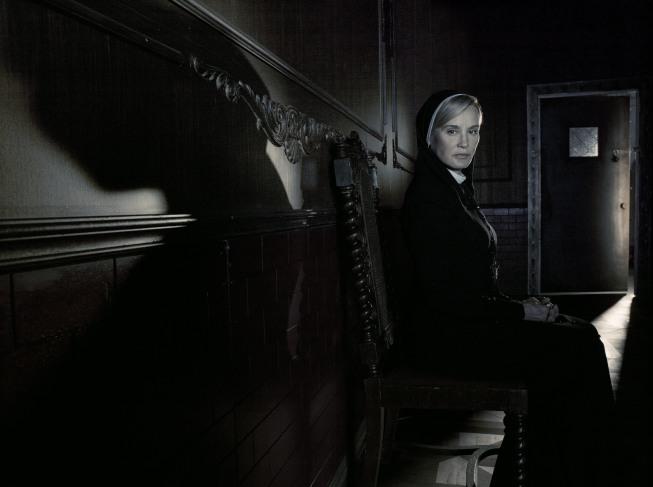In this week’s finale episode of American Horror Story: Asylum, we learned that Lana Winter’s ticket to fame was not her journalistic writing, as she had originally planned, but her skill brandishing a microphone on camera. After exposing the decrepitude of Briarcliff in prime time to much acclaim, Lana became the host of a “gotcha” news magazine show called America Unmasked. It’s almost too perfect, that show title: Transpose that kind of probing to the darker elements of American mythology, and you’ve got an ideal tagline for AHS in general.
Lana said in her Kennedy Center Honors interview that she wanted “to take America inside the asylum”—exactly what AHS helmsmen Ryan Murphy and Brad Falchuk did this season. Except that in their narrative sanitarium, the cells don’t just house “visually stimulating” crazy people; the truly scary things living here—stuffed under the mattress next to Shelley’s cucumber, perhaps—are far less “entertaining” and far more uncomfortably familiar. They are the creaks and groans that haunt our collective American dream.
Given the admittedly exhausting buildup of storylines and characters we saw in the middle of this season, it’s easy to forget some of the real horrors that AHS critiqued. For starters, take the racism invoked by the response to Kit and Alma’s union, or the chillingly nonchalant homophobia directed towards Lana and Wendy. But those monsters seem almost cuddly when compared to the portrait of America’s atrocious relationship with mental illness that the show so graphically presents, and which has recently been highlighted by discussions surrounding the Newtown shootings. True, institutions like Briarcliff Manor have mostly been shuttered over the past half-century, but our struggle to treat mentally ill people as worthy, nuanced human beings lives on, even if under a more politically correct veneer. Don’t forget: After 13 episodes of exploitative, sometimes nauseating images of human misery, we were left with no clear salvation for the residents of Briarcliff who supposedly “deserved” to be there. They simply disappeared, and any pleasure we took in those images should be on our consciences; though I doubt that few even thought, like Jen Chaney did in our chat, of their fates. I know I didn’t.
If this sounds a little preachy, forgive me. I’m only trying to counter the prevailing opinion that American Horror Story is just a madcap entertainment with a void at its core. Quite the contrary: If taken seriously (which, admittedly, Murphy and co. sometimes make difficult), it seems to me to be one of the most ethically weighty shows on television. Both seasons thus far have encouraged—at times even demanded—that we ask awkward questions about specters that haunt the American landscape: school shootings, women’s reproductive rights, treatment of the mentally ill—the list goes on. And it’s probably no accident that both seasons have featured a protagonist whose profession—an investigative reporter and a psychiatrist—involves digging below the surface of things, often finding something unsavory (as Lana literally did in the finale) underneath. Taking AHS for nothing more than a creepy romp is the laziest way to engage with it; remove that mask (or that skin, if you like) and things get richer and a heck of a lot more complicated.
In the end, though, American Horror Story does not seem terribly interested in answering the questions it raises within its fundamentally dark view of American life. We could take this as simply disturbing, or we could go further and wonder whether those questions have answers at all. But either way, AHS has done its mirror-wielding work. Sister Jude said it best: “If you look in the face of evil, evil’s gonna look right back at you.”
